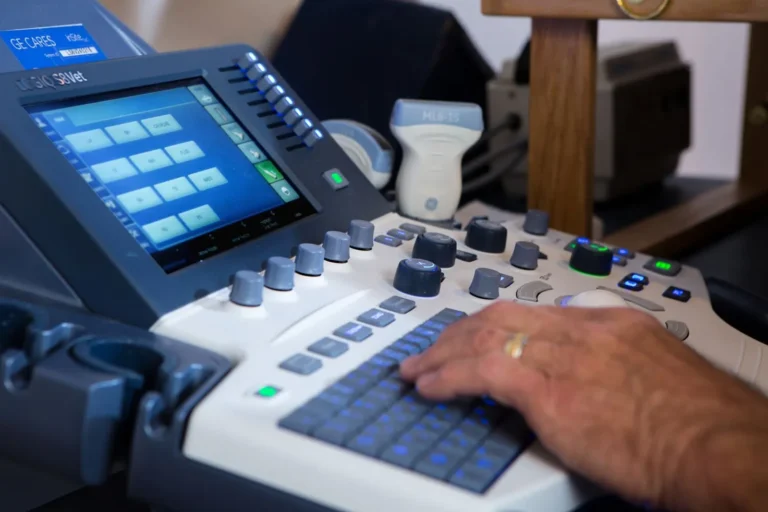Top Tips Summarized by Dr. Seitz DVM, DACVR, DABVP
- You will need a plan to implement the new modality in your clinic to get the most value out of your Ultrasound.
- Establish measurable, time-sensitive goals that encompass:
- When you and your personnel will complete introductory, intermediate, advanced, and refresher training courses
- How you and your personnel will gradually increase usage of Ultrasound
- How will you charge clients for Ultrasound
- Make sure your personnel commits to performing “missed opportunity scans.” The two biggest ones are ultrasound-guided cystocentesis and Focused Assessment with Sonography in Trauma (FAST) scans in emergency situations.
- When you’re comfortable with cystos and FAST scans, you can take intermediate courses to learn to use Ultrasound to properly assess major abdominal organs and more challenging GI tract, pancreas, and lymph nodes. From there, you can take advanced courses and eventually offer full diagnostic scans, which typically bring in about $250 or more per scan, depending on the location of your practice.
- It takes practice to grow comfortable using Ultrasound. “You’re going to need training. You’re going to make mistakes. Be patient and practice. Don’t be too hard on yourself. It’s going to take time,” explained Dr. Seitz.
- Not all training programs are created equal. When comparing your options, consider
- The number of instructors and their credentials.
- The most important factor in an ultrasound training program is how much time you will spend scanning a live animal in the lab with an instructor by your side.
- Space apart your training courses to give yourself time to practice your new skills.
- Beyond formal training, brush up on your ultrasound knowledge by attending online webinars, short courses, and conferences. Self-directed learning, such as reading medical literature on veterinary Ultrasound, is also beneficial.
- Another popular resource is the Sound Education Portal, which has free introductory and refresher ultrasound training videos by instructors from the Academy of Veterinary Imaging. It can be found at
- As you grow more comfortable and familiar with Ultrasound, you will refer out fewer clients and be able to accept more referrals from doctors in your network.
- Make sure your personnel commit to performing “missed opportunity scans” (FASTscans and ultrasound-guided cystos)
- Write out your implementation plan and put it where you can see it daily.
- Use ultrasound adjunct to radiography to confirm suspected diagnoses.
- Perform focused scans on organs while patients are undergoing other treatments.
- Ask your personnel to remind you to use Ultrasound when an opportunity presents itself.
- Put your ultrasound machine where it can be easily accessed—not next to the kennels in a back room.
- First, it is necessary to ask, “How do you plan to use ultrasound in your practice?” The response might differ for a low-volume referral hospital and a high-volume veterinary clinic focusing on preventative care.
- Talk to your sales rep about the warranty. The better ones include sending a loaner the next day, which is imperative if you only have one ultrasound machine.”
- If you intend to do full diagnostic scans at the general practitioner level, invest in a $60,000 to $100,000 machine. Don’t buy a $100,000 machine if you’ll only use it forcystos and FAST scans.
- Don’t get oversold. Think about what you need to maximize your return on your investment. Dr. Seitz states, “It’s better to buy a cheap machine and pay for it that year than to buy an expensive machine and let it go unused.
- Charge! It is essential that you charge appropriately. Don’t just charge one price for an ultrasound, even though it’s one machine. Do you charge one price for blood work? Probably not, because your blood analysis machine has many uses in your practice, just like Ultrasound.
- The fees you charge to clients for Ultrasound will depend on where your practice is located, but you can use the slide below as a guide:
- Tips to help you create a fee schedule for Ultrasound:
- Consider “batch” charges to generate more revenue and increase ultrasound utilization
- Increase your cystocentesis fee to include the Ultrasound
- Increase your emergency fee to include a FAST scan
- Charge a combined fee for abdominal radiographs and ultrasound
- Introduce a “recheck” fee to encourage repeat scans at a reduced price
- Talk to other doctors in your area. Explain how you’re currently using ultrasound and what you’re currently charging, and ask for feedback

- The single most common mistake made by veterinarians new to Ultrasound is the need for an implementation plan.
- Another common mistake is not recognizing the learning curve involved. Training and practice are essential. Dr. Seitz recommends that you perform at least two or three scans each week to start and look for opportunities to scan patients while they are undergoing other treatments. “Break out of your patterns preventing you from using ultrasound.”
- A final mistake is working outside the machine’s capability. If your machine is over ten years old, performing full scans or examining GI lymph nodes will be frustratingly challenging.
Conclusion
Ultrasound is a powerful diagnostic modality that belongs in most veterinary practices. If you want to get the most value out of your ultrasound system, follow Dr. Seitz’s advice and create a detailed implementation plan. Consider how you and your personnel will develop your skills and expand your usage of Ultrasound over time. When comparing your options, don’t get oversold on an ultrasound with unnecessary frills that inflate the price. Your purchasing decision should be based on your intended use of your ultrasound and the specific features you need. By following these guidelines and sticking to your fee schedule, Ultrasound will boost your revenue, improve the standard of care in your clinic, and help you develop a reputation for being on the

